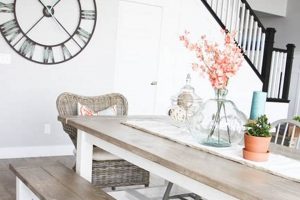The creation of a small-scale photography platform by individuals, utilizing readily available materials, enables controlled product or object imaging. Such constructions generally feature a translucent surface upon which the subject is placed, coupled with a backdrop that can be adjusted for optimal illumination and shadow management. For instance, a crafter might construct a miniature studio using PVC pipes, diffusion fabric, and clamps to photograph handmade jewelry for online sale.
These homemade platforms offer several advantages, primarily cost savings and customization. Commercial photography equipment can represent a significant investment. Constructing an equivalent allows entrepreneurs and hobbyists to reduce overhead. Moreover, it is customizable, enabling precise tailoring to the specific needs of product dimensions and preferred lighting conditions. Historically, photographers often relied on elaborate studio setups, but this more compact and affordable approach has democratized access to professional-quality product photography.
The subsequent sections will elaborate on the various design approaches, material selections, lighting considerations, and construction techniques that contribute to the successful creation and utilization of these customized photography aids.
Tips for Building a Stable Photography Platform
Creating a robust and effective small-scale photography platform requires attention to detail and careful planning. The following tips will assist in constructing a stable and functional platform suitable for product or object photography.
Tip 1: Material Selection is Paramount: Opt for rigid and durable materials for the frame. PVC pipe, wood, or metal can provide structural support. Ensure the chosen material can withstand the weight of the intended subject matter.
Tip 2: Diffusion is Critical: Use a translucent, light-diffusing material for the shooting surface. Acrylic sheeting or frosted plexiglass evenly distributes light, minimizing harsh shadows and creating a softer, more appealing look. Consider light transmission properties of the diffusion material.
Tip 3: Secure and Adjustable Backdrop: Design the backdrop to be easily replaceable and adjustable. Fabric backdrops offer versatility in color and texture. A clamping mechanism ensures the backdrop stays taut and wrinkle-free.
Tip 4: Pay Attention to Dimensions: Determine the ideal dimensions based on the largest product intended to be photographed. A larger shooting surface provides greater flexibility in composition, but excessively large platforms can be unwieldy. Balance size with usability.
Tip 5: Light Placement Considerations: Plan for versatile light placement options. Consider integrating mounting points for lamps or reflectors. Ensure lighting can be easily adjusted to achieve optimal illumination angles and intensities.
Tip 6: Stability is Key: Prioritize the overall stability of the structure. A wobbly platform will compromise image sharpness. Reinforce joints and connections to prevent movement during shooting sessions.
Tip 7: Consider Portability: If the platform needs to be moved frequently, design it with portability in mind. Consider using lightweight materials and a modular design that can be easily disassembled and reassembled.
By adhering to these tips, constructors can ensure the finished platform delivers consistent, high-quality results, reducing post-processing time and enhancing the presentation of photographed items.
The following sections will delve into specific design considerations and techniques for optimizing the performance of the customized photography aid.
1. Stability
The stability of a photography platform is a paramount consideration in its design and construction. An unstable platform introduces the potential for unwanted movement during image capture, directly impacting image sharpness and overall quality. Therefore, ensuring a stable foundation is critical for consistently achieving professional-grade results.
- Material Rigidity
The selection of materials with high rigidity directly contributes to the overall stability. For instance, using thick-walled metal tubing for the frame, rather than thin PVC pipe, minimizes flexing and vibration during use. Conversely, a structure constructed from flexible materials is prone to movement, which could require longer exposure times to compensate, thereby increasing the risk of motion blur.
- Joint Integrity
The integrity of the joints connecting the various components of the photography platform is crucial. Bolted or welded connections, for example, provide superior stability compared to friction-fit or loosely glued joints. The strength of the joint directly resists forces that could cause the structure to shift or wobble during operation. This is especially pertinent for platforms designed to hold heavier items.
- Weight Distribution
Even weight distribution across the platform’s base enhances stability. A design that concentrates weight on one side may become unstable and prone to tipping. Ensuring the base is wider than the upper structure and that weight is evenly distributed reduces the likelihood of unintended movement, improving the predictability and repeatability of photographic setups.
- Vibration Dampening
Integrating vibration-dampening measures minimizes the impact of external vibrations on the photography platform. For example, adding rubber feet to the base isolates the platform from vibrations transmitted through the floor. This approach helps prevent minute, yet significant, movements that can compromise image sharpness, especially when using longer focal lengths or macro lenses.
In conclusion, the stability of a photography platform is a function of material properties, joint construction, weight distribution, and vibration isolation. Addressing each of these aspects during construction directly influences the platform’s ability to consistently deliver sharp, high-quality images.
2. Lighting Control
Effective lighting control is integral to the utility of a DIY photography platform. A carefully constructed table, regardless of its structural integrity, is limited without the capacity to manipulate and optimize illumination. The integration of lighting strategies directly influences the quality and professional appearance of the resulting images.
- Positioning and Angle Adjustment
The ability to precisely adjust the position and angle of light sources relative to the subject is critical. Platforms featuring adjustable lamp mounts or stands allow for targeted illumination. For example, repositioning lights higher and further away can reduce harsh shadows, while lower, angled lights can emphasize texture. The flexibility in angling lighting allows for nuanced control over highlights and shadows, enabling professional aesthetic results.
- Diffusion and Reflection
Utilizing diffusion materials, such as softboxes or diffusion panels, softens the light output, minimizing harsh shadows and creating a more flattering illumination. Reflectors, on the other hand, redirect light into shadowed areas, balancing the overall exposure. A common practice might include positioning a reflector opposite a key light to fill in shadows on a product’s surface, enhancing detail and visual appeal.
- Light Source Selection
The selection of appropriate light sources impacts color temperature and intensity. LED panels offer variable color temperatures and consistent output, whereas incandescent bulbs produce warmer tones. Choosing the appropriate light source, either natural or artificial, is dependent on the desired aesthetic and the subject matter. For instance, photographing jewelry may benefit from cool, bright LED light to accentuate the facets of the gems.
- Background Illumination
Illuminating the background independently provides an additional layer of control. Separating the subject from the background with targeted lighting enhances depth and visual interest. For instance, a backlight positioned behind a product creates a subtle glow, highlighting the subject’s outline and creating a clean, professional look. This level of control is essential for achieving polished, marketable product photographs.
These facets demonstrate the deep connection between manipulating light sources and the effectiveness of the photography platforms. The ability to adjust positioning, diffuse or reflect light, select appropriate light sources, and control background illumination transforms a simple structure into a tool capable of producing high-quality, professional photographs.
3. Material Selection
The selection of appropriate materials is a foundational aspect of small-scale photography platform construction. The chosen materials directly influence the platform’s structural integrity, load-bearing capacity, light diffusion properties, and overall longevity. Informed decisions regarding material selection are therefore crucial for the successful implementation of these specialized photography setups.
- Frame Materials and Stability
The materials used for the frame, which provides the primary support structure, dictate the platform’s overall stability. Options range from lightweight PVC pipe to more robust wood or metal. PVC offers affordability and ease of assembly, but lacks the rigidity of wood or metal. Hardwoods, such as maple or birch, provide enhanced stability, while metal frames, often constructed from aluminum or steel, offer the highest load-bearing capacity. The selection should align with the anticipated weight and dimensions of the objects to be photographed.
- Diffusion Surface Transparency and Texture
The diffusion surface, typically positioned above the frame, is responsible for evenly distributing light and minimizing harsh shadows. Common materials include translucent acrylic sheeting, frosted plexiglass, and diffusion fabrics. Acrylic and plexiglass offer durability and are easily cleaned, while diffusion fabrics provide a softer light quality. The choice depends on the desired aesthetic and the intensity of the light source. Rougher textures on the diffusion surface will scatter light more widely, reducing specular highlights, while smoother surfaces maintain a greater degree of light transmission.
- Background Material Reflectivity and Color
The background material contributes significantly to the overall composition and mood of the photograph. Options range from seamless paper backdrops to fabric drapes or painted boards. Matte surfaces minimize unwanted reflections, while glossy surfaces can introduce specular highlights. The color of the background material influences the perceived color temperature of the photograph. Neutral tones, such as white, gray, or black, offer versatility, while colored backgrounds can create specific moods or emphasize product features.
- Fasteners and Adhesives Durability and Compatibility
The fasteners and adhesives used to assemble the photography platform play a critical role in its long-term durability. Screws, bolts, and rivets provide secure mechanical connections, while adhesives, such as epoxy or construction adhesive, offer a more permanent bond. The choice of fasteners and adhesives should be compatible with the selected frame and diffusion surface materials. For example, using screws designed for wood with a metal frame may compromise the structural integrity of the platform. Similarly, using an adhesive that is not compatible with acrylic sheeting can result in discoloration or weakening of the bond over time.
Ultimately, the selection of materials for the small-scale photography platform represents a series of trade-offs between cost, durability, aesthetics, and ease of construction. A comprehensive understanding of material properties and their influence on the photographic process is essential for creating a functional and effective photography tool.
4. Size appropriateness
The determination of appropriate dimensions is a critical consideration during the construction of a small-scale photography platform. The physical size of the platform directly influences its usability, efficiency, and the quality of resulting imagery. A mismatch between the platform’s dimensions and the size of the objects being photographed can lead to operational difficulties and compromised photographic outcomes.
- Object Dimensions and Shooting Area
The primary driver of platform size is the dimensions of the objects intended for photography. A platform must provide sufficient surface area to comfortably accommodate the largest object, allowing for adequate space around the perimeter for lighting and compositional adjustments. For instance, a platform intended for photographing small jewelry items requires significantly less surface area than one intended for larger items, such as shoes or handbags. Inadequate shooting area restricts camera angles and limits compositional options.
- Lighting and Shadow Management
Platform size also impacts lighting and shadow management. A larger platform offers greater flexibility in light placement, allowing for more controlled illumination and shadow sculpting. Conversely, a smaller platform may limit the available angles for light positioning, potentially leading to harsh shadows or uneven illumination. This is especially relevant when using multiple light sources or employing techniques such as bounce lighting or diffusion.
- Camera Field of View and Working Distance
The camera’s field of view and working distance must be considered when determining platform size. A wider field of view allows for capturing more of the scene within a single frame, potentially reducing the need for a larger platform. However, working distance, the distance between the camera and the subject, also influences the required platform size. Shorter working distances may necessitate a larger platform to accommodate the camera and lens while maintaining the desired composition. Macro photography, for example, often requires a greater working distance and, consequently, a larger platform.
- Storage and Portability Considerations
Practical considerations such as storage space and portability also play a role in determining appropriate platform size. A larger platform, while offering greater flexibility, may be more difficult to store and transport. If the platform is intended for mobile use or requires frequent relocation, a smaller, more compact design may be preferable, even if it necessitates some compromise in terms of shooting area or lighting flexibility.
In summary, determining appropriate dimensions for a photography platform is a balancing act between the size of the objects being photographed, the desired lighting and compositional flexibility, and practical constraints such as storage and portability. Careful consideration of these factors ensures that the platform is both functional and efficient, maximizing its utility as a photographic tool.
5. Background Versatility
Background versatility represents a critical aspect in the effective application of a small-scale photography platform. The ability to modify the backdrop behind a subject directly impacts the overall aesthetic and contextual presentation of the image. Integrating features that facilitate background changes significantly enhances the platform’s utility, allowing for a wider range of photographic styles and applications.
- Interchangeable Backdrop Systems
The implementation of a system that allows for quick and easy replacement of backgrounds is a fundamental component of background versatility. This can involve using a slot-in design where various backdrops (paper, fabric, boards) can slide into a frame, or a clamping mechanism to secure different materials. For instance, a photographer might switch between a seamless white paper backdrop for clean product shots and a textured fabric backdrop for a more artistic feel. This adaptability minimizes post-processing and allows for in-camera creative control.
- Color and Texture Variety
Offering a diverse range of colors and textures in background options expands the creative possibilities. Solid colors provide a clean and distraction-free environment, allowing the subject to take center stage. Textured backgrounds, such as wood, brick, or fabric, can add depth and visual interest. A jeweler, for example, might use a velvet backdrop to highlight the luster of precious stones or a rustic wood backdrop to create a vintage aesthetic. The availability of multiple options facilitates tailored presentations to match brand guidelines or artistic vision.
- Adjustable Depth of Field
Strategic use of background distance and aperture settings can create a blurred background, directing the viewer’s attention to the subject. This technique is particularly effective for isolating products and minimizing distractions. For example, a shallow depth of field can blur a busy background, creating a professional and clean look for product photography. By experimenting with aperture settings and background distance, users can achieve diverse visual effects that enhance the overall image.
- Seamless Integration and Minimal Distractions
A well-designed background system minimizes seams, wrinkles, and other visual distractions that can detract from the subject. Seamless paper backdrops are commonly used for this purpose, providing a smooth and uniform surface. Fabric backdrops should be stretched taut to eliminate wrinkles. By minimizing visual distractions in the background, the focus remains firmly on the subject, resulting in a polished and professional photograph.
In conclusion, background versatility on a photography platform is essential for photographers seeking to create diverse and visually appealing images. The implementation of interchangeable systems, a range of color and texture options, careful control of the depth of field, and seamless integration contribute to the platforms overall effectiveness. These elements enhance creative control and contribute to consistently professional results.
6. Portability
Portability, when considered within the context of small-scale photography platforms, directly affects its range of applications and potential user base. A platform’s inherent design either facilitates or impedes its ability to be easily transported, thereby limiting or expanding the environments and scenarios in which it can be effectively employed. The construction of a photography platform prioritizing ease of transport typically involves design choices that sacrifice some degree of rigidity or size, presenting a trade-off. For instance, a photographer who frequently shoots on location might choose a lightweight, collapsible design, accepting the compromise of a slightly smaller shooting surface or reduced weight-bearing capacity. The cause-and-effect relationship is clear: a desire for greater transportability necessitates design alterations that may affect other performance characteristics.
The importance of transportability is particularly evident in situations requiring on-site product photography, such as documenting items at trade shows, craft fairs, or client locations. A platform that can be quickly assembled and disassembled, and easily carried, saves time and reduces logistical challenges. Consider a small business owner who sells handmade goods at various markets. A portable platform enables them to efficiently photograph new products at each event, maintaining consistent image quality for their online store and marketing materials. This ability to create professional-looking images on location directly impacts their branding and sales efforts.
Understanding the practical significance of transportability allows constructors to tailor designs to specific needs. A platform intended solely for studio use may prioritize maximum stability and size, while one intended for field work prioritizes weight reduction and ease of breakdown. Challenges associated with portability include maintaining structural integrity while minimizing weight and ensuring easy assembly without sacrificing stability. Despite these challenges, the benefits of a transportable photography platformincreased flexibility, expanded shooting locations, and enhanced efficiencymake it a valuable asset for many photographers and small business owners.
7. Diffusion quality
The efficacy of a DIY photography platform is intrinsically linked to the diffusion quality achieved through the selected materials and setup. Proper diffusion mitigates harsh shadows, reduces specular highlights, and ensures even illumination across the subject, which directly impacts the professional appearance of the final image.
- Material Translucency and Light Scattering
The translucency of the material used for the shooting surface dictates the degree of light scattering. Highly translucent materials allow a large amount of light to pass through with minimal diffusion, potentially resulting in harsh shadows. In contrast, materials with greater opacity scatter light more effectively, producing softer, more diffused illumination. A diffusion material with optimized light scattering properties is critical for minimizing unwanted shadows and creating a visually appealing aesthetic when using a DIY platform.
- Surface Texture and Specular Highlight Reduction
The surface texture of the diffusion material significantly impacts the presence of specular highlights, which are bright, concentrated reflections of the light source. Rougher textures scatter light more randomly, reducing the intensity of specular highlights and creating a more matte finish. Conversely, smoother surfaces tend to produce stronger specular highlights, which can be distracting and detract from the subject. Selecting a material with appropriate surface texture contributes to a well-balanced and visually pleasing image by controlling specular reflections.
- Light Source Distance and Uniformity
The distance between the light source and the diffusion surface directly influences the uniformity of illumination. Placing the light source too close can create a hotspot in the center of the shooting surface, resulting in uneven lighting. Increasing the distance allows the light to spread more evenly across the diffusion material, creating more uniform illumination. Optimizing the distance between the light source and the diffusion material enhances the overall quality of the light and minimizes variations in brightness across the subject when using a DIY setup.
- Color Neutrality and White Balance Accuracy
The color neutrality of the diffusion material affects the accuracy of white balance in the resulting images. Materials with a noticeable color cast can distort the color of the light passing through, leading to inaccurate color representation. Selecting a diffusion material with minimal color cast ensures that the colors in the photograph accurately reflect the subject’s true colors. This is particularly important for product photography, where accurate color representation is essential for online sales and marketing materials.
In conclusion, achieving optimal diffusion quality on a DIY photography platform requires careful consideration of material translucency, surface texture, light source distance, and color neutrality. Attention to these factors significantly enhances the aesthetic appeal and accuracy of the resulting images, increasing their value for various applications, from online sales to personal projects. The ability to control and refine diffusion within these DIY frameworks elevates them from simple constructs to effective imaging tools.
Frequently Asked Questions
The following questions address common inquiries and misconceptions regarding the construction and utilization of do-it-yourself photography platforms.
Question 1: What is the primary advantage of a self-constructed photography platform versus a commercially manufactured one?
The principal advantage is cost reduction. Commercially available photography tables can represent a substantial capital outlay, whereas a self-constructed alternative allows for significant savings by leveraging readily available, lower-cost materials.
Question 2: What constitutes a suitable material for the diffusion surface of a photography platform?
Appropriate materials include translucent acrylic sheeting, frosted plexiglass, or diffusion fabric. The selected material should effectively scatter light, minimize harsh shadows, and maintain color neutrality to ensure accurate color representation in the resulting photographs.
Question 3: How can the stability of a self-made photography platform be optimized?
Stability is enhanced through the selection of rigid frame materials, secure joint construction, and even weight distribution. Bolted connections and the implementation of vibration-dampening measures, such as rubber feet, further improve stability.
Question 4: What is the recommended method for ensuring a seamless background on a photography platform?
Seamless backgrounds are typically achieved through the use of continuous paper backdrops or tightly stretched fabric backdrops. Wrinkles and creases should be eliminated to minimize visual distractions and maintain a professional appearance.
Question 5: How can lighting be effectively controlled on a DIY photography platform?
Effective lighting control involves adjustable lamp positioning, the use of diffusion and reflection materials, and strategic background illumination. The flexibility to modify light angles and intensities is essential for achieving optimal illumination.
Question 6: What factors should be considered when determining the appropriate size of a photography platform?
The primary factors include the dimensions of the objects intended for photography, the desired camera field of view, the working distance, and storage and portability considerations. The platform should accommodate the largest anticipated object while remaining manageable and easily stored.
These responses provide concise explanations addressing frequent inquiries related to DIY photography platforms. Understanding these concepts aids in successful construction and application.
The subsequent section will present advanced techniques for optimizing the performance of a self-constructed photography platform.
Shooting Table DIY
This exploration of shooting table diy has highlighted the core elements that contribute to a functional and effective product photography aid. From material selection and structural stability to diffusion techniques and illumination strategies, each factor plays a critical role in determining the quality and consistency of resulting images. The considerations presented emphasize that this practice is more than simple construction; it is a deliberate process of optimizing resources for a specific photographic outcome.
The potential to tailor a photographic tool precisely to individual needs, coupled with the cost savings achieved, positions shooting table diy as a valuable resource for both amateur and professional photographers. Continued experimentation and refinement of techniques will further unlock the potential of these customized platforms, democratizing access to high-quality product imagery and furthering the growth of small businesses and creative endeavors. Further research of lighting tools would be beneficial.


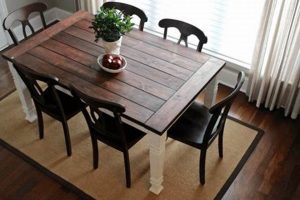
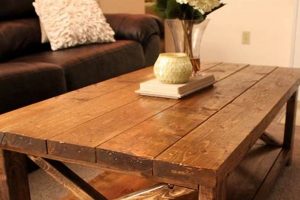
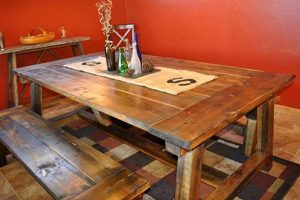
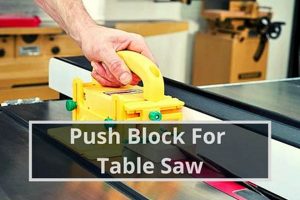
![Build a Safe DIY Table Saw Push Stick [Guide] The DIY Hub: Creative Crafts, Repairs & Life Hacks Build a Safe DIY Table Saw Push Stick [Guide] | The DIY Hub: Creative Crafts, Repairs & Life Hacks](https://craftingdiycenter.com/wp-content/uploads/2025/07/th-4323-300x200.jpg)
